Sure, everyone’s heard of the glitz and glamour of Rio de Janeiro, but if you’re looking for the real Brazilian superstar that’s stealing the show, let me introduce you to Bonito! Tucked away in the heart of Mato Grosso do Sul, Bonito is like the hidden VIP lounge in the Brazilian tourism scene, where natural beauty, adventure, and relaxation come together for an exclusive bash that rivals the carnival spirit of its more famous cousin. By the way: “Bonito” is Portuguese and means “beautiful”. And this is not an understatement!
Table of Contents
Toggle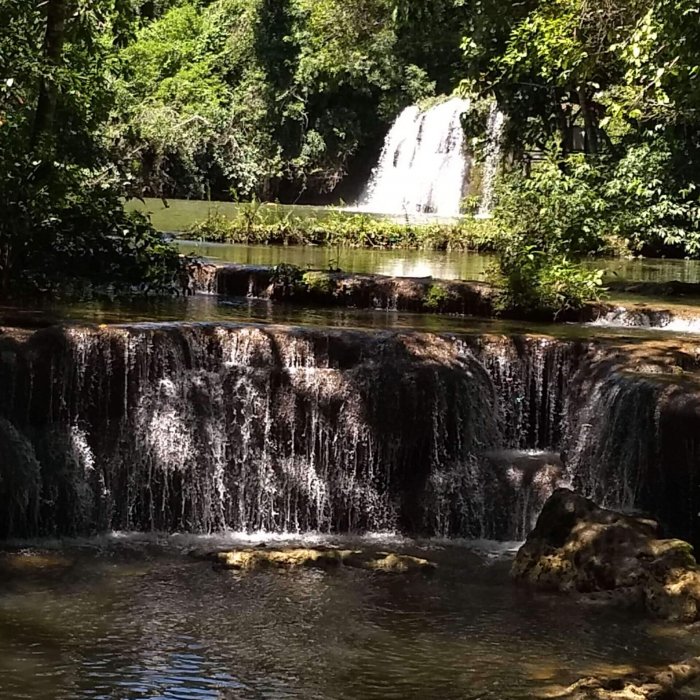
Where is Bonito?
Bonito is a town located in the state of Mato Grosso do Sul, Brazil. It is situated in the southwestern part of the country, in the central-western region of Brazil. Bonito is known for its stunning natural attractions, crystal-clear rivers, diverse ecosystems, and unique adventures, making it a popular destination for nature lovers and adventure seekers.
The town is surrounded by lush forests and is renowned for its ecotourism and sustainable tourism practices. If you plan to visit Bonito, you’ll likely fly into Campo Grande, the capital of Mato Grosso do Sul, and then travel to Bonito, which is approximately 300 kilometers (186 miles) southwest of Campo Grande.
What you need to know before travelling to Bonito?
- In most cases, the power plugs are set to 110v, but it’s advisable to bring bi-volt electronics as some accommodations may have 220v outlets.
- It’s not recommended to consume water directly from the tap or fountains as it may lead to stomach discomfort. You have to buy it.
- All agencies take the same prices for the adventures. You cannot go on your own without a ticket to any of the areas as they are on private ground.
- The easiest way to go around is by car or taxi as the attractions are mostly deep in the country.
How much does it cost to go to Bonito, Mato Grosso do Sul?
Curious about what to bring on your trip to Bonito? Here’s a checklist:
- Sunscreen and repellent (opt for biodegradable versions if possible. You can buy it in Bonito but it will be more expensive there!).
- Cutlery kit, reusable straw, grocery bags and water bottle.
- Sunglasses
- Water shoes
- Hiking shoes or sturdy hiking boots – some tours mandate closed shoes for trekking.
- Hiking sandals
- Sun-protective clothing
- Waterproof jacket
What to take to Bonito?
Curious about what to bring on your trip to Bonito? Here’s a checklist:
- Sunscreen and repellent (opt for biodegradable versions if possible. You can buy it in Bonito but it will be more expensive there!).
- Cutlery kit, reusable straw, grocery bags and water bottle.
- Sunglasses
- Water shoes
- Hiking shoes or sturdy hiking boots – some tours mandate closed shoes for trekking.
- Hiking sandals
- Sun-protective clothing
- Waterproof jacket
Don't do this in Bonito
While Bonito stands out as one of Brazil’s most organized ecotourism destinations with a strong environmental focus, it grapples with ongoing challenges, including deforestation, rainfall, and agricultural activities that occasionally lead to river clouding, as seen in the case of Rio Formoso.
At the municipal level, reconsidering the prevalent use of plastic bottles, plasticand cups within the city could be beneficial. A potential solution involves hotels and tourist sites offering water gallons for visitors to refill their reusable bottles, thus mitigating the demand for single-use plastic bottles.
Animal-focused tourism remains a concern as well. In certain locations, activities such as posing for photos with macaws and boa constrictors, or manipulating them, persist.
Here are some eco-friendly travel suggestions:
- Carry reusable items like straws, glassware, grocery bag and bottles to minimize waste while on your journey.
- Purchase a large water gallon (5 liters or more) from local markets to refill your reusable bottles.
- Refrain from using chemical products on your body and hair before entering natural bodies of water, such as rivers, ponds, and waterfalls, to prevent water contamination.
- Maintain a safe distance and avoid touching or hugging wild animals.
- Resist the temptation to feed wild animals, especially with the intention of luring them closer.
- Refrain from taking selfies with wild animals, as doing so contributes to the exploitation of animals in tourism. Familiarize yourself with ethical practices in wildlife tourism for more information.
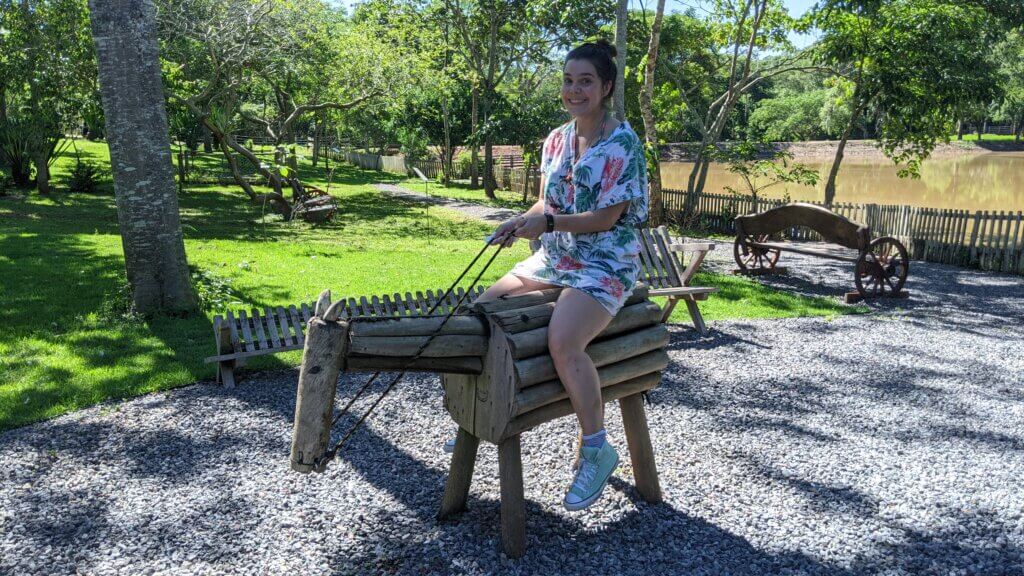
When to go to Bonito?
An ideal period to explore Bonito is from June to September, characterized by milder temperatures, reduced rainfall, and enhanced visibility in the natural fluctuations. While the water may be a bit cooler during this time, the use of wetsuits during float trips ensures warmth. Additionally, this season offers the optimal opportunity to witness the local celebrity macaws.
In the midst of summer’s warmth, the waterfalls become the focal point of attention. With increased rainfall, their water volume surges, rendering them even more stunning and inviting for a refreshing dip. Prices during this period may also be more enticing. Nevertheless, it’s worth noting that rain might affect visibility on the coveted floating tours in Bonito.
Avg. Temperature in Bonito, Brazil
January
26.2 °C, 79.2 °F
April
24.4 °C, 75.9 °F
July
19.7 °C, 67.4 °F
August
21.9 °C, 71.4 °F
November
25.6 °C, 78 °F
February
25.9 °C, 78.6 °F
May
20.9 °C, 69.7 °F
June
20.1 °C, 68.2 °F
September
24 °C, 75.2 °F
December
26.1 °C, 79 °F
March
25.5 °C, 78 °F
June
20.1 °C, 68.2 °F
July
19.7 °C, 67.4 °F
October
25.6 °C, 78.1 °F
How long staying in Bonito?
In Bonito, there’s a multitude of activities to engage in, prompting the recommendation of scheduling a stay of at least five days. Ideally, ten days would provide a leisurely pace, allowing you to delve into both the well-known attractions and venture beyond the typical tourist spots.
For those seeking a comprehensive exploration of the region, aiming for more distant locales or opting for immersive experiences, extending your stay to 20 days is a viable option without the need for tour repetition.
Where to stay in Bonito?
Choosing where to stay in Bonito depends on your preferences and budget. Bonito offers a range of accommodation options, including hotels, hostels, lodges, and eco-friendly resorts. Here are some popular areas and types of accommodations to consider:
1. Downtown Bonito: Staying in the town center allows easy access to restaurants, shops, and local attractions. You’ll find a mix of hotels and hostels catering to various budgets.
2. Ecotourism Lodges: For a more immersive experience, consider eco-friendly lodges located closer to natural attractions. These lodges often blend with the surrounding environment and provide a nature-centric stay.
3. Farm Stays: Some visitors opt for farm stays, providing a rustic experience while being close to nature. These accommodations offer a glimpse into rural life in the region.
4. Resorts: Bonito has upscale resorts that cater to travelers seeking luxury and comfort. These resorts often have amenities like swimming pools, spa facilities, and organized tours.
5. Guesthouses: Local guesthouses provide a more personalized experience, allowing you to connect with the local culture. Hosts may offer valuable insights into the best places to explore.
When choosing where to stay in Bonito, consider factors such as proximity to the attractions you want to visit, amenities offered, and the type of experience you seek. Booking in advance, especially during peak seasons, is advisable to secure your preferred accommodation.
6. Or you decide to stay in our lovely, cozy house:
Plan Your Trip to Bonito:
How to get there?
Getting to Bonito involves a combination of air and ground transportation. Here’s a general guide:
By Air:
1. Fly to Campo Grande:
Your journey to Bonito begins with a flight to Campo Grande International Airport (Aeroporto Internacional de Campo Grande – CGR).
Secure a flight to Campo Grande from major cities in Brazil or connect through larger international airports in the country.
2. From Campo Grande to Bonito:
Bonito is approximately 300 kilometers away from Campo Grande, and you have several transportation options.
By Bus:
Opt for a bus journey from Campo Grande to Bonito, a scenic route taking around 4-5 hours. Trusted bus companies like Cruzeiro do Sul and Viação São Luiz operate services to Bonito.
If you’re opting for a bus journey from the capital, the ride takes approximately 5 hours and is priced at R$130* per person per leg when using the Vanzella company.
By Rental Car:
Enjoy flexibility by renting a car from agencies at the Campo Grande airport. The 4-hour drive to Bonito allows you to savor the landscapes at your own pace.
By Shuttle or Transfer:
Consider the convenience of shuttle services or transfers provided by hotels and travel agencies in Campo Grande. This option ensures a comfortable journey directly to Bonito. For transfers between cities, prices can begin at R$100* per journey, and the travel time to Bonito typically spans around 4 hours.
(*Note: Prices are approximate and subject to change.)
Essential Tip: Download an Offline Map for Your Bonito Adventures!
Before embarking on your Bonito adventures, ensure a seamless experience by downloading an offline map. While the town itself boasts good signal coverage, the rural nature of the routes means you’ll be traversing areas with no phone connection whatsoever.
Bonito’s breathtaking landscapes and hidden gems are often nestled in remote, natural surroundings. Picture yourself surrounded by lush greenery, crystal-clear rivers, and vibrant ecosystems – all the elements that make Bonito truly enchanting. However, it’s in these off-the-beaten-path areas that your phone signal might bid you farewell.
So, here’s the golden rule: Always have an offline map ready! Whether you’re heading to the Gruta do Lago Azul, navigating the Rio Sucuri, or venturing to the Buraco das Araras, having an offline map ensures you won’t miss a beat.
Which attraction should I book?
There are so many things you can do in Bonito and to make a choice is not always easy. But here we go with our recommandations:
1. Snorkeling in Rio da Prata or Sucuri River:
Explore crystal-clear waters teeming with fish and aquatic vegetation. These rivers offer a mesmerizing snorkeling experience.
2. Gruta do Lago Azul (Blue Lake Cave) Tour:
Descend into a captivating cave with a vibrant blue lake. The tour provides a unique underground adventure.
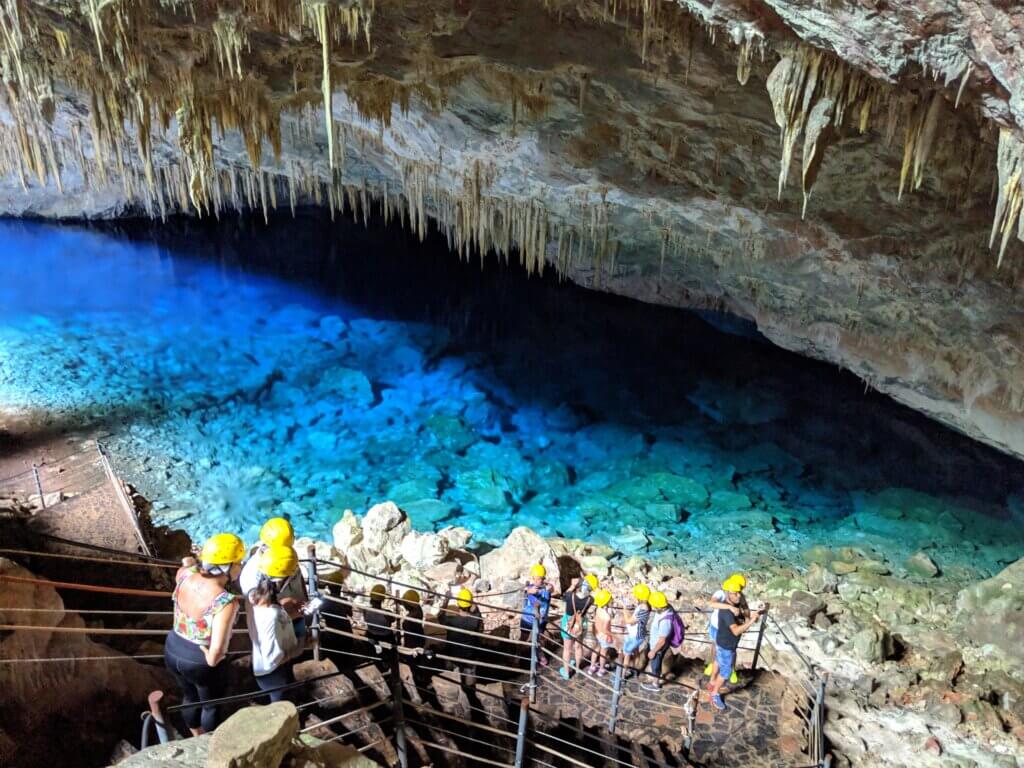
3. Abismo Anhumas (Anhumas Abyss) Abseiling:
For thrill-seekers, this adventure involves rappelling down 70 meters!! into an enormous underground cavern and exploring a subterranean lake.
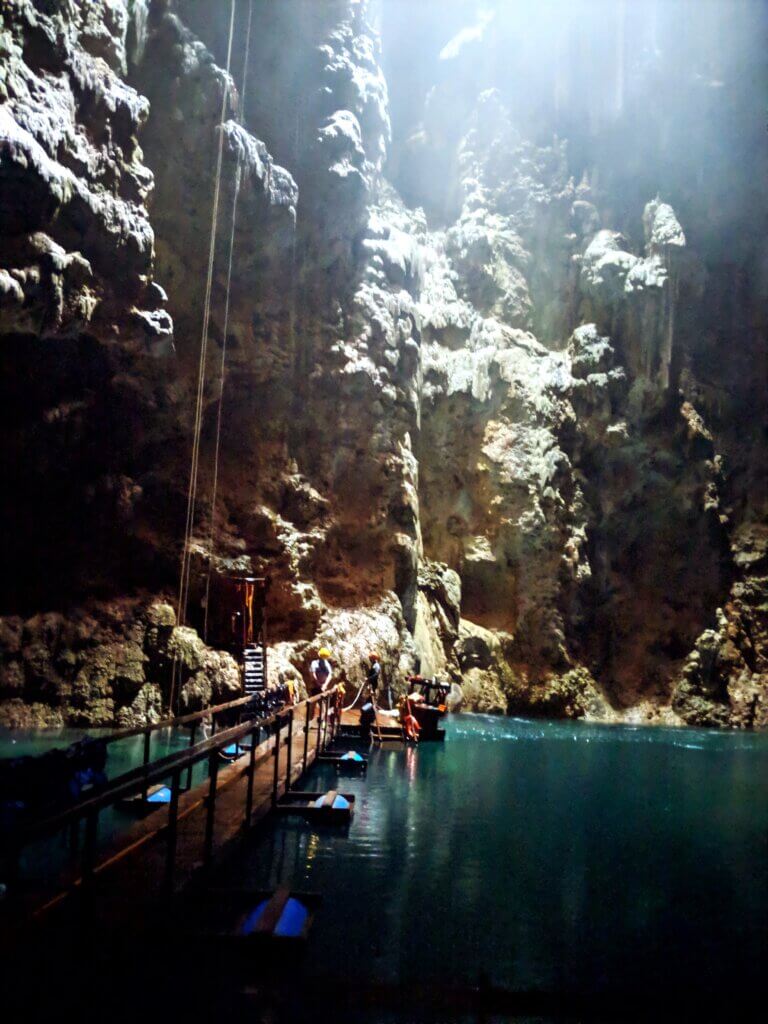
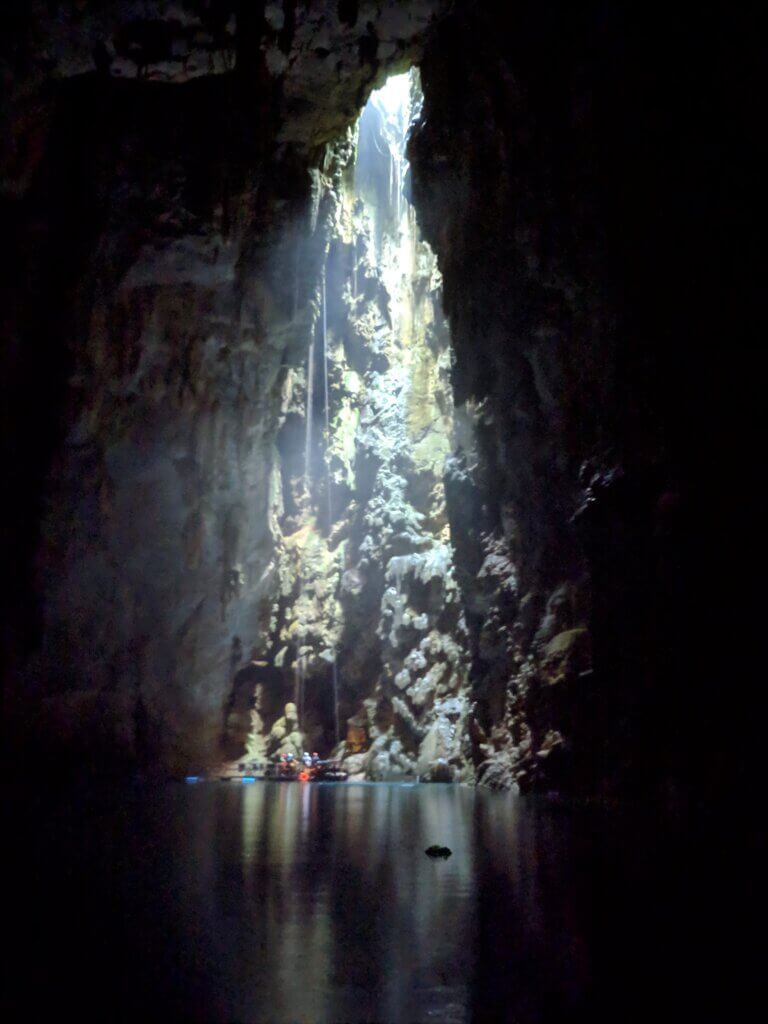
4. Floating in Rio Sucuri or Rio Prata:
Enjoy a leisurely float on pristine rivers, observing the underwater life through your snorkel mask.
5. Lagoa Misteriosa (Mysterious Lagoon) Scuba Diving:
Dive into a deep and mysterious sinkhole with crystal-clear water, revealing stunning underwater landscapes.
6. Balneário Municipal (Municipal Bath):
Relax in natural pools formed by the Rio Formoso. It’s a great spot for swimming and enjoying the beautiful surroundings.
7. Adventure Trails in Grutas de São Miguel (Saint Michael Caves):
Embark on guided hiking trails to explore the diverse landscapes around these captivating limestone caves.
8. Boca da Onça Waterfall Trail:
Hike through the lush forest to reach the Boca da Onça waterfall, one of the tallest waterfalls in the state of Mato Grosso do Sul.
IMPORTANT HINT: Remember to book your adventures in advance, especially during peak seasons, and check the requirements for each activity. Some activities may have specific physical fitness or age restrictions, so make sure to choose adventures that align with your preferences and capabilities.
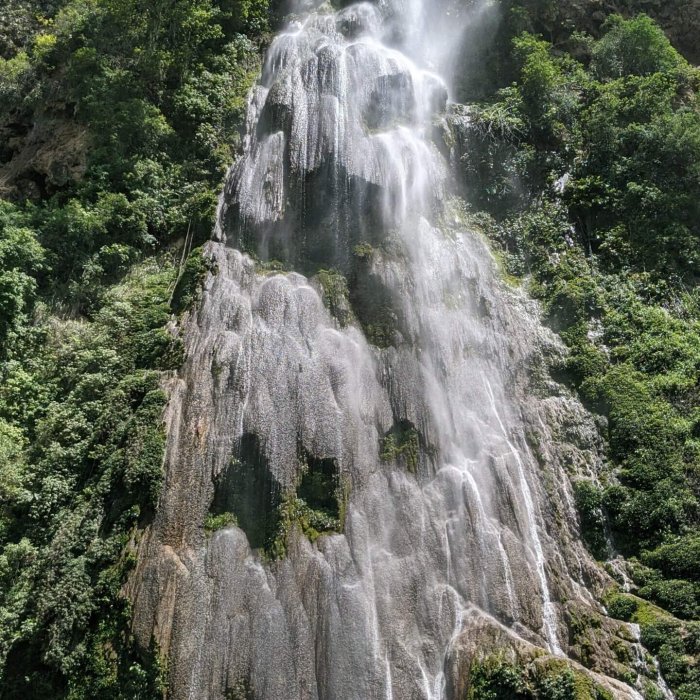
IMPORTANT HINT: Remember to book your adventures in advance, especially during peak seasons, and check the requirements for each activity. Some activities may have specific physical fitness or age restrictions, so make sure to choose adventures that align with your preferences and capabilities.